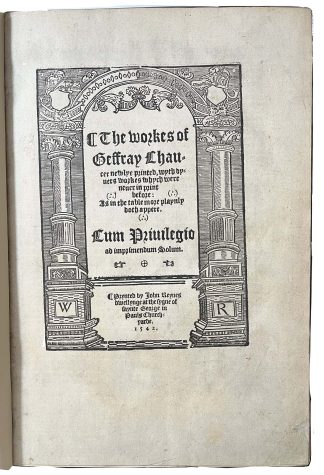CHAUCER, Geoffrey.
LARGE COMPLETE COPY
The workes of Geffray Chaucer.
London, John Reynes, 1542.£195,000.00
Folio. Separate titles to each part, continuous pagination, ff. [8], CCCLXXXXII. Black letter, double column. Titles within woodcut border with publisher’s initials, 20 1/3-page woodcuts (some repeated) portraying the pilgrims of the Canterbury Tales, decorated initials. Lightly washed, title slightly dusty, tear without loss at head of fol.56, outer margin of fols 342-345 (touching few words, without loss), lower edge of fol.17 and last three ll. strengthened, gutter of last 3 ll. repaired (supplied?). A very good, large copy in C19 crushed crimson morocco by C. Lewis, triple gilt ruled, spine gilt (sunned), gilt monogram WHM (W.H. Miller) to spine, inner edges gilt ruled, marbled eps, a.e.g. Armorial device of Sir James Ware (1594-1666), preserved from original binding, identified by Rosenbach with confirmatory letter from his company.
A large copy of the second collected edition of Chaucer’s works, with handsome woodcuts of the ‘The Canterbury Tales’ produced using the original blocks of Caxton’s second edition (1483), and the first appearance in print of ‘The Plowman’s Tale’. Rare on the market and the earliest edn. still found complete, though the present copy apart, not since 1943.
‘With the possible exception of Langland, except Dante, there is no poet of the middle ages of superior faculty and distinction’ (DNB). Celebrated as the ‘father of English Literature’ by the likes of Hoccleve and Dryden, he was the most influential writer to use the kind of English language, i.e., middle English, spoken at court, but not yet regularly employed in literature. This makes him the oldest English author still readable today. Chaucer (1340-1400) was employed as a courtier and civil servant, whilst also writing, foundational Middle English verse and a prose treatise on the astrolabe, under the patronage of the Duke of Lancaster. He was the first author to be buried in Poets’ Corner, at Westminster Abbey, as well as the first English poet to experiment with rhyme royal, and to use a decasyllabic verse much resembling the iambic pentameter which would later become the norm. The reception of his works changed the course of English Literature, even though, by the late Tudor period, his literary English had started to sound archaic, with regular ‘updates’ of his spelling. ‘Few authors took such productive advantage of Chaucerian permissiveness as William Shakespeare, whose narrative poems defer to Chaucer’s distinctively English authority with a regularity comparable to his uses of Homer, Ovid, Virgil and Plutarch’ (Hollifield).
The collection opens with ‘The Canterbury Tales’. Unlike previous editions, the present includes ‘The Plowman’s Tale’, which is a text of Wycliffite and anti-monarchical leanings, circulated among the Lollards. Excluded from the Chaucer canon in 1775, it was not universally considered his work. The charming woodcuts were produced by an English artist for Caxton’s second edition. ‘In 1542, nearly 60 years after their first appearance, blocks from Caxton’s original series were used for the last time in an edition of the “Canterbury Tales”, in a reprint of the 1532 Thynne edition […]’ (Carlson, pp.26-7, 32-3). The remainder of the volume includes Chaucer’s translation of Jean de Meun and Guillaume de Lorris’ allegorical ‘Roman de la Rose’; ‘Troylus and Criseyde’, a poem elaborating on the Homeric ‘Matter of Troy’ interpreted through the alleged eye-witness accounts of Dictys, Dares, Caxton and Lydgate, which were major sources for medieval chivalric romance; ‘The Legend of Good Women’, on virtuous women in history; his translation of Boethius’s ‘Consolation of Philosophy’; his treatise on the astrolabe; the ‘Book of Fame; and numerous shorter poems. A handsome copy.
A trace of early Irish ownership survives in the arms of Sir James Ware (1594-1666), preserved from the C17 binding discarded in the C19. Ware studied at Trinity College, Dublin, was a bibliophile, collector of mss, and author of books on Irish antiquities. In 1632, he was Auditor-General in Ireland, and was later imprisoned as a Royalist in the Tower of London. A note by K.D. Rapoport traces previous ownership to the Britwell Library (31 March 1924, lot 150), Lord Amherst and Richard Heber (perhaps lot 812 in his 1834 sale).
STC (2nd ed.), 5070; ESTC S107200; Lowndes I, p.395. Not in Pforzheimer. D.R. Carlson, ‘Woodcut Illustrations of the Canterbury Tales, 1483-1602’, The Library, 19 (1997), pp.25-67; S.A. Hollifield, ‘Shakespeare adapting Chaucer’ (unpublished PhD thesis, Univ. of Nevada, 2010); T. Prendergast, 30 Great Myths about Chaucer (2020).







